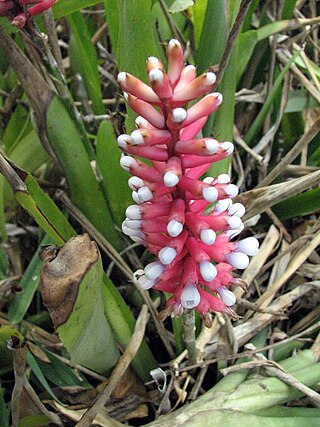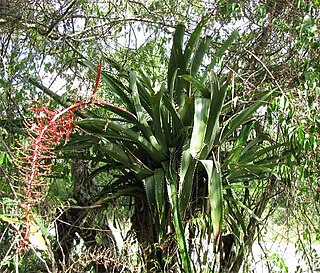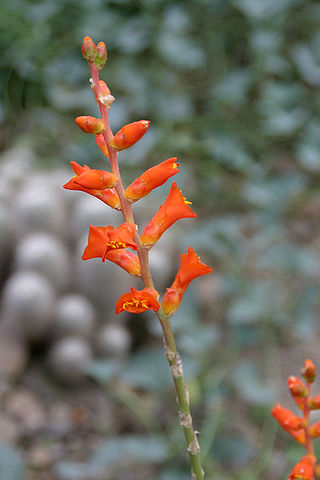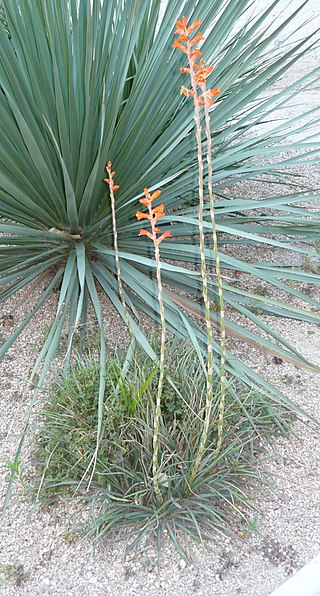
Aechmea cylindrata is a bromeliad, native to southeastern Brazil from São Paulo to Santa Catarina. This plant is cited in Flora Brasiliensis by Carl Friedrich Philipp von Martius, and it is often used as an ornamental plant.

Aechmea gamosepala is a bromeliad endemic to southern Brazil. It is often cultivated as an ornamental plant. This plant is cited in Flora Brasiliensis by Carl Friedrich Philipp von Martius

Aechmea nudicaulis is a bromeliad species in the genus Aechmea, which is often used as an ornamental plant. This species is native to Central America, the West Indies, central and southern Mexico, and northern and central South America.

Aechmea distichantha, the Brazilian vaseplant, or vase plant, is a bromeliad typical of Cerrado vegetation in Brazil, which is also native to northern Argentina, Bolivia, Paraguay, and Uruguay. This plant is often used as an ornamental plant.

Billbergia nutans, or Queen's-tears, is an epiphytic bromeliad native to Brazil, Paraguay, Uruguay, and Argentina.

Hohenbergia stellata is a perennial species of the genus Hohenbergia. It is native to Trinidad and Tobago, Martinique, Netherlands Antilles, Venezuela, and northeastern Brazil.

Aechmea coelestis is a species of flowering plant in the genus Aechmea. This is a species that is native to southeastern Brazil from Espírito Santo to Santa Catarina.

Dyckia leptostachya is a plant species in the genus Dyckia. This species is native to Brazil, Bolivia, Paraguay, and Argentina.

Aechmea aquilega is a plant species in the genus Aechmea. This species is native to Brazil, Venezuela, the Guianas, Trinidad, Jamaica and Costa Rica.

Aechmea bambusoides is a plant species in the genus Aechmea. This species is endemic to Brazil. It is native to the States of Minas Gerais and Rio de Janeiro. Mature fruits (berries) are pyriform, white and contain seeds spread in a fleshy transparent mucilage. Seeds are falcate-shaped, with a narrow micropylar portion, rough texture, brown-red colour and no appendages.

Aechmea emmerichiae is a species of flowering plant in the genus Aechmea. This species is endemic to Chapada Diamantina National Park in eastern Brazil.
Aechmea organensis is a plant species in the genus Aechmea. This species is endemic to southeastern Brazil.

Tillandsia geminiflora is a species in the genus Tillandsia. This species is native to Brazil, Suriname, Paraguay, Uruguay, and the Misiones Province of Argentina.

Tillandsia polystachia is a species of flowering plant in the genus Tillandsia. This species is native to Central America, the West Indies, Bolivia, Colombia, Brazil, Ecuador, Mexico and Venezuela.

Aechmea bracteata is a plant species in the genus Aechmea. This species is native to Central America, Mexico, Colombia, and Venezuela; it is also reportedly naturalized in the Bahamas.

Aechmea lueddemanniana is a species in the genus Aechmea. This species is native to Costa Rica, Guatemala, Belize, Honduras, Nicaragua and southern Mexico as far north as Veracruz.

Aechmea setigera is a plant species in the genus Aechmea. This species is native to Bolivia, Venezuela, Colombia, Panama, Suriname, French Guiana, Ecuador, and northern Brazil.

Aechmea lingulata is a plant species in the genus Aechmea. This species is native to the West Indies, Costa Rica, Panama and northern South America.

Dyckia rariflora is a plant species in the genus Dyckia endemic to the State of Minas Gerais in Brazil.

Dyckia remotiflora is a plant species in the genus Dyckia. It is native to Argentina, Uruguay, and Brazil.





















